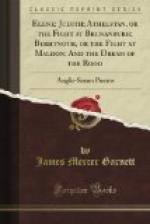The similarity of thought in the personal epilogue
(II. 122 ff.) to the epilogue of the ELENE (II. 1237
ff.) is striking, and they may be compared by the
curious reader. The translation is made from the
Grein-Wuelker text (Vol. II., pp. 116-125), with
emendations from others, as seen in the notes.
All can agree with Kemble (
Codex Vercellensis,
Part II., p. ix) that “it is in some respects
the most striking of all the Anglo-Saxon remains,
inasmuch as a departure from the mere conventional
style of such compositions is very perceptible in it.
It contains some passages of real poetical beauty,
and a good deal of fancy.” Brooke says
(op. cit., p. 443): “This is the last of
the important poems of the eighth century. It
is good, but not very good. The older part, if
my conjecture be right, is the best, and its reworking
by Cynewulf has so broken it up that its dignity is
much damaged. The shaping is rude, but the imagination
has indeed shaped it.” ten Brink says (p. 53):
“Cynewulf himself has immortalized this vision
in a poem, giving utterance to an irrepressible emotion,
but still exhibiting the delicate lines of a beautifully
designed composition.” The other Germans
are usually so taken up with technical and mechanical
questions that they leave no room for aesthetic considerations.
Whether Cynewulf wrote the poem or not,—and
the probabilities favor his authorship, though we
may not hesitate to say with Morley, “I don’t
know,”—it is certainly the work of
a gifted Christian poet, who reverences the cross
as the means of the redemption of mankind.
This brief Introduction will, it is hoped, be sufficient
to interest the reader in the accompanying translations
of some of the finest pieces of Old English poetry
that remain to us from the eighth, ninth, and tenth
centuries. The earlier period was the golden age
of Old English poetry in the Northumbrian dialect,
which poetry, there is good reason to think, was copied
into the West-Saxon dialect, and it now remains to
us only in that form; for, when the Northmen harried
Northumbria, destroyed its monasteries, massacred
its inhabitants, and settled in its homes, manuscripts
perished, and the light of learning in Western Europe
was extinguished. It is sufficient to recall
King Alfred’s oft-quoted lament, in the Preface
to his translation of Pope Gregory’s “Pastoral
Care,” to realize the position held by Northumbria
in respect to culture, and when learning was restored
in Wessex by the efforts of the king himself, and
poetry again revived, it shone but by a reflected
light. Still we should treasure all that remains,
and the Old English language should be at least as
well known as Latin is now, and should occupy as prominent
a position in education and general culture. Until
that millennial period arrives, translations of Old
English poems may not be without service.
ABBREVIATIONS IN NOTES.




